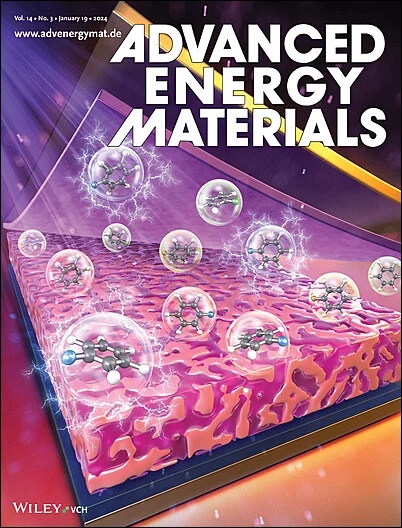SCOF Hollow Fiber Constructing Ion Selective Conduction Nano-Pipeline Network for Vanadium Redox Flow Batteries
IF 26
1区 材料科学
Q1 CHEMISTRY, PHYSICAL
引用次数: 0
Abstract
Hollow covalent organic frameworks (COFs) can decrease the resistance of proton conduction, however, the current micro-spherical or nano-rod morphology makes COFs only act as a disperse phase in membranes due to low aspect ratio. Herein, hollow fiber morphology of sulfonated covalent organic framework (HF-SCOF) is fabricated for the first time via a dissolution-diffusion control of monomers in different solvents during the electrospinning-solvothermal synthesis. The HF-SCOF mat is long-range orientated, with water/acid uptake in core cavity layer, and abundant sulfonic acid groups and protonated secondary amine along shell layer, thus establish continuous H+/Vn+ ion selective conduction nano-pipeline network in the membrane to maximize the advantages of SCOFs materials. Densified by sulfonated polybenzimidazole, the composite membrane exhibits excellent performance of vanadium redox flow battery. The energy efficiency reaches 81.9% at a high current density of 200 mA cm−2, and keeps stable during 1000 charging/discharging cycles, surpassing the performance of currently reported COFs-based membranes.

SCOF中空纤维构建钒氧化还原液流电池离子选择性传导纳米管网
空心共价有机框架(COFs)可以降低质子的传导阻力,但目前的微球形或纳米棒形态使得COFs在膜中由于长径比低而只能作为分散相。本文首次通过电纺丝-溶剂热合成过程中单体在不同溶剂中的溶解-扩散控制,制备了磺化共价有机骨架(HF-SCOF)的中空纤维形态。HF-SCOF薄膜具有远程取向,在核心空腔层吸收水/酸,沿壳层有丰富的磺酸基和质子化仲胺,从而在膜内建立连续的H+/Vn+离子选择性传导纳米管网,最大限度地发挥了scof材料的优势。复合膜采用磺化聚苯并咪唑致密化,具有优异的钒氧化还原液流电池性能。在200 mA cm−2的高电流密度下,能量效率达到81.9%,并且在1000次充放电循环中保持稳定,超过了目前报道的基于cofs的膜的性能。
本文章由计算机程序翻译,如有差异,请以英文原文为准。
求助全文
约1分钟内获得全文
求助全文
来源期刊

Advanced Energy Materials
CHEMISTRY, PHYSICAL-ENERGY & FUELS
CiteScore
41.90
自引率
4.00%
发文量
889
审稿时长
1.4 months
期刊介绍:
Established in 2011, Advanced Energy Materials is an international, interdisciplinary, English-language journal that focuses on materials used in energy harvesting, conversion, and storage. It is regarded as a top-quality journal alongside Advanced Materials, Advanced Functional Materials, and Small.
With a 2022 Impact Factor of 27.8, Advanced Energy Materials is considered a prime source for the best energy-related research. The journal covers a wide range of topics in energy-related research, including organic and inorganic photovoltaics, batteries and supercapacitors, fuel cells, hydrogen generation and storage, thermoelectrics, water splitting and photocatalysis, solar fuels and thermosolar power, magnetocalorics, and piezoelectronics.
The readership of Advanced Energy Materials includes materials scientists, chemists, physicists, and engineers in both academia and industry. The journal is indexed in various databases and collections, such as Advanced Technologies & Aerospace Database, FIZ Karlsruhe, INSPEC (IET), Science Citation Index Expanded, Technology Collection, and Web of Science, among others.
 求助内容:
求助内容: 应助结果提醒方式:
应助结果提醒方式:


